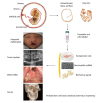Perinatal stem cells: A promising cell resource for tissue engineering of craniofacial bone
- PMID: 25621114
- PMCID: PMC4300925
- DOI: 10.4252/wjsc.v7.i1.149
Perinatal stem cells: A promising cell resource for tissue engineering of craniofacial bone
Abstract
In facing the mounting clinical challenge and suboptimal techniques of craniofacial bone defects resulting from various conditions, such as congenital malformations, osteomyelitis, trauma and tumor resection, the ongoing research of regenerative medicine using stem cells and concurrent advancement in biotechnology have shifted the focus from surgical reconstruction to a novel stem cell-based tissue engineering strategy for customized and functional craniofacial bone regeneration. Given the unique ontogenetical and cell biological properties of perinatal stem cells, emerging evidence has suggested these extraembryonic tissue-derived stem cells to be a promising cell source for extensive use in regenerative medicine and tissue engineering. In this review, we summarize the current achievements and obstacles in stem cell-based craniofacial bone regeneration and subsequently we address the characteristics of various types of perinatal stem cells and their novel application in tissue engineering of craniofacial bone. We propose the promising feasibility and scope of perinatal stem cell-based craniofacial bone tissue engineering for future clinical application.
Keywords: Bone tissue engineering; Craniofacial bone regeneration; Extraembryonic tissue; Perinatal stem cells.
Figures

Similar articles
-
Cellular Senescence in Craniofacial Tissue Regeneration: Inducers, Biomarkers, and Interventions.Tissue Eng Part B Rev. 2024 Feb;30(1):128-141. doi: 10.1089/ten.TEB.2023.0136. Epub 2023 Sep 11. Tissue Eng Part B Rev. 2024. PMID: 37565284 Review.
-
Bone marrow-derived mesenchymal stem cells for regenerative medicine in craniofacial region.Oral Dis. 2006 Nov;12(6):514-22. doi: 10.1111/j.1601-0825.2006.01300.x. Oral Dis. 2006. PMID: 17054762 Review.
-
Advances of mesenchymal stem cells derived from bone marrow and dental tissue in craniofacial tissue engineering.Curr Stem Cell Res Ther. 2014 May;9(3):150-61. doi: 10.2174/1574888x09666140213142258. Curr Stem Cell Res Ther. 2014. PMID: 24524798 Review.
-
Reconstruction of Craniofacial Bone Defects with Autologous Human Bone Marrow Stem Cells and Autogenous Bone Grafts: A Case Report with Review of Literature.J Pharm Bioallied Sci. 2020 Aug;12(Suppl 1):S394-S398. doi: 10.4103/jpbs.JPBS_116_20. Epub 2020 Aug 28. J Pharm Bioallied Sci. 2020. PMID: 33149493 Free PMC article.
-
Reconstruction of Craniomaxillofacial Bone Defects Using Tissue-Engineering Strategies with Injectable and Non-Injectable Scaffolds.J Funct Biomater. 2017 Nov 20;8(4):49. doi: 10.3390/jfb8040049. J Funct Biomater. 2017. PMID: 29156629 Free PMC article. Review.
Cited by
-
Stem cells and COVID-19: are the human amniotic cells a new hope for therapies against the SARS-CoV-2 virus?Stem Cell Res Ther. 2021 Mar 1;12(1):155. doi: 10.1186/s13287-021-02216-w. Stem Cell Res Ther. 2021. PMID: 33648582 Free PMC article. Review.
-
Human amniotic membrane conditioned medium inhibits proliferation and modulates related microRNAs expression in hepatocarcinoma cells.Sci Rep. 2019 Oct 2;9(1):14193. doi: 10.1038/s41598-019-50648-5. Sci Rep. 2019. PMID: 31578445 Free PMC article.
-
Comparison of the effects of preservation methods on structural, biological, and mechanical properties of the human amniotic membrane for medical applications.Cell Tissue Bank. 2024 Mar;25(1):305-323. doi: 10.1007/s10561-023-10114-z. Epub 2023 Oct 15. Cell Tissue Bank. 2024. PMID: 37840108 Review.
-
Proliferation and survival of human amniotic epithelial cells during their hepatic differentiation.PLoS One. 2018 Jan 18;13(1):e0191489. doi: 10.1371/journal.pone.0191489. eCollection 2018. PLoS One. 2018. PMID: 29346426 Free PMC article.
-
Combination of stem cell therapy and acupuncture to treat ischemic stroke: a prospective review.Stem Cell Res Ther. 2022 Mar 3;13(1):87. doi: 10.1186/s13287-022-02761-y. Stem Cell Res Ther. 2022. PMID: 35241146 Free PMC article. Review.
References
-
- Ward BB, Brown SE, Krebsbach PH. Bioengineering strategies for regeneration of craniofacial bone: a review of emerging technologies. Oral Dis. 2010;16:709–716. - PubMed
-
- Yuan J, Cao Y, Liu W. Biomimetic scaffolds: implications for craniofacial regeneration. J Craniofac Surg. 2012;23:294–297. - PubMed
-
- Genden EM. Reconstruction of the mandible and the maxilla: the evolution of surgical technique. Arch Facial Plast Surg. 2010;12:87–90. - PubMed
-
- Mendonça JJ, Juiz-Lopez P. Regenerative facial reconstruction of terminal stage osteoradionecrosis and other advanced craniofacial diseases with adult cultured stem and progenitor cells. Plast Reconstr Surg. 2010;126:1699–1709. - PubMed
Publication types
LinkOut - more resources
Full Text Sources
Other Literature Sources

